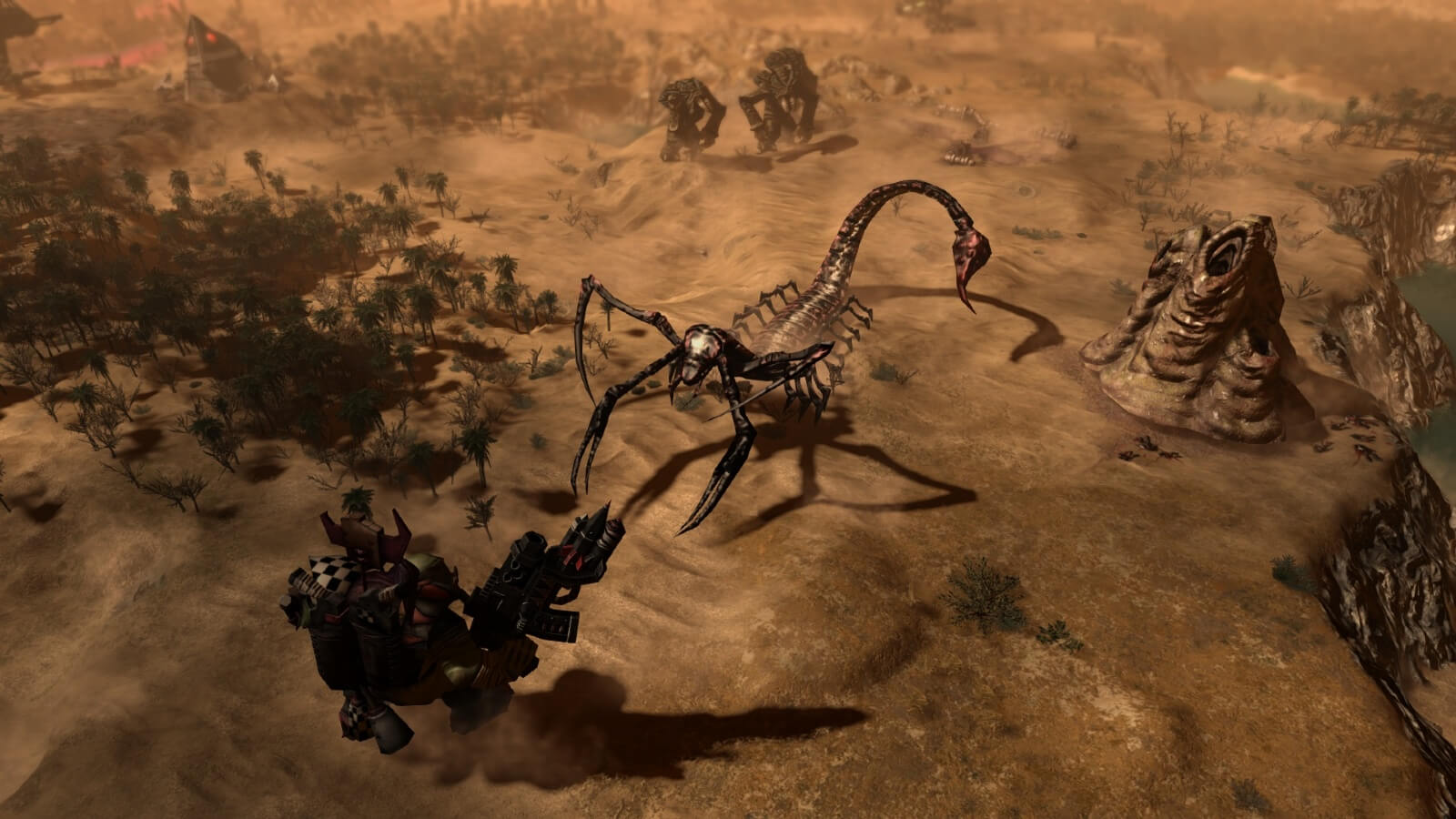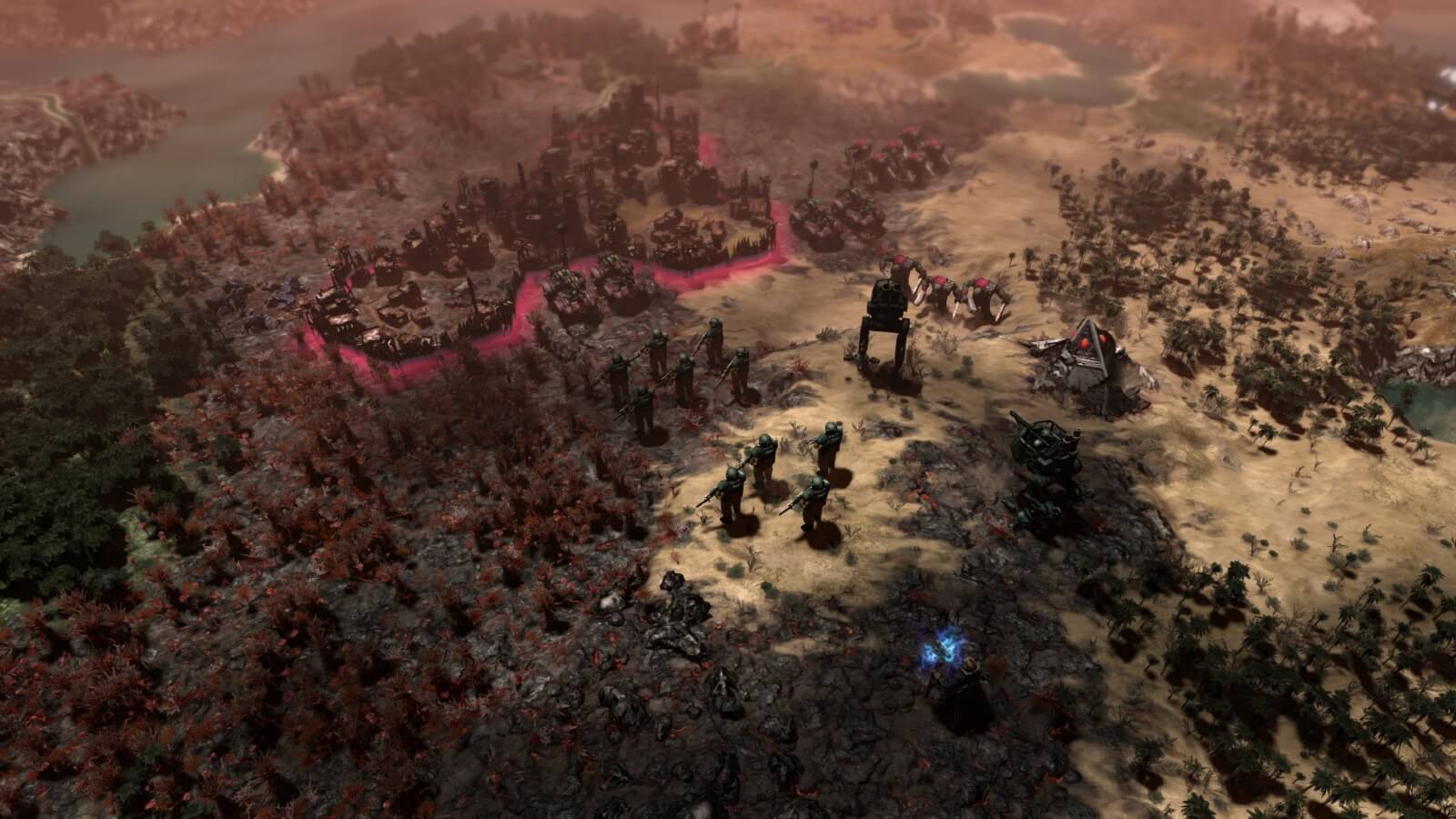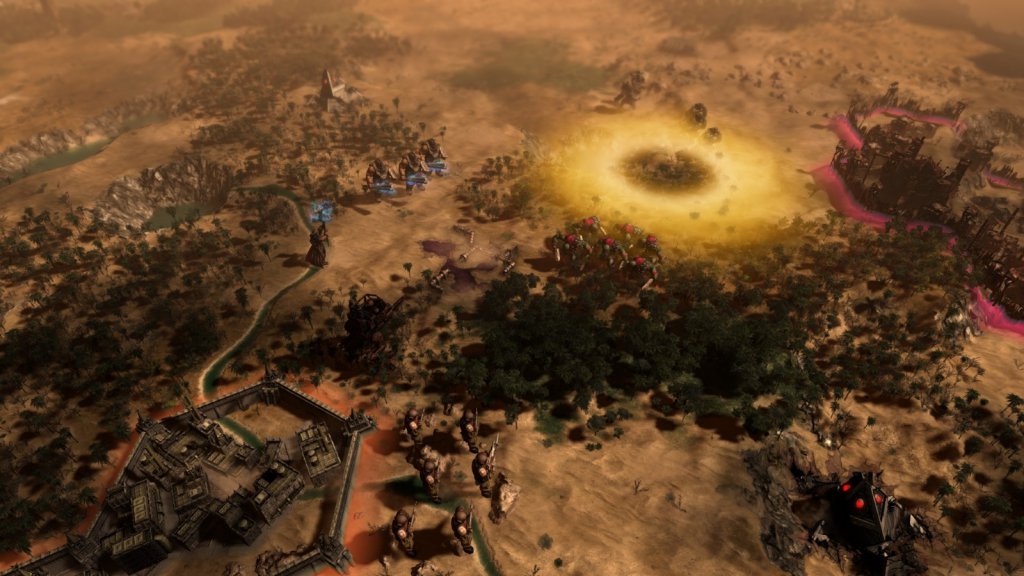In the grim darkness of the far future there is only war… or at least so it says in a chunk of the commonly cited Warhammer 40,000 universe declaration. Warhammer 40,000: Gladius – Relics of War, takes that as its mantra, and wears it with a smile.
Warhammer 40,000: Gladius – Relics of War sees players leading (at launch) one of four factions as they race to uncover the secrets of a deadly, unforgiving world. Unlike the vast majority of the games using Games Workshop’s license, it’s a 4X, turn-based title. That said, in keeping with the setting it is definitely more focused on the Xterminate of the four Xs. Rok Breulj — one half of Proxy Studios, the developers of the game — gave me a guided tour of the first hour of play while I was at the recent PC Gamer Weekender. My session, in the shoes of the Astra Militarum (AKA Imperial Guard), was one pocked with chuckles, sighs and excited gasps.
The Imperial Guard, for those of you unfamiliar with the setting, are the red shirts (that’s another science fiction culture reference, Dann, that doesn’t help) of the setting — a kind of militia who tend to be barely holding ground, or being bled dry, when the ‘heroes’ of the setting arrive in almost any game. The ‘heroes‘, the Space Marines — a biologically and cybernetically engineered pack of religious zealots who worship an emperor kept immortal by the daily sacrifice of thousands — are already on the scene on Gladius Prime, as were the game’s two other factions, the Orks and Necron.

Each of the game’s four factions control in their own way, featuring their own playstyles and quirks, as well as faction-specific tech trees. Space Marines can only have one city; Orks can gain resources through combat victories; Necrons can only build on specific, ruined tiles; and the Astra Militarum can deploy city-wide edicts. It’s rare to have vastly different factions at immediate odds with one another — and from my experiences with combat, this felt as fair and balanced as any conflict in the 40k universe.
That said, even without the three other contesting factions, the planet Gladius Prime itself seems to hates you. For a start, there’s wire weed — a bio-engineered, acidic plant which damages everything it touches — all over the place. There’s also death-world wildlife like Catachan Devil (Angry Milipede-Scorpion) hives all over the place, as well as various mutated hounds, abandoned and malfunctioning imperial defences from the last time they tried to hold out on the planet, Psychneuein and worse. The wildlife and terrain ensure that you’re always pushing back against something, even before the other factions clock onto your location and start preparing their efforts to wipe you off the face of the planet.
In many ways, as Rok explained to me, the easiest game to draw comparisons to Warhammer 40,000: Gladius is a split between the most recent Civilization titles, at least in the way that combat, exploration and movement play out. It’s hex-based and you can’t stack units on the same tiles, although units can attack over more distances than simply adjacent tiles. As a matter of fact, a standout point for me was how units could have multiple attack types, each with their own range and some with multiple effects. One unit’s attack strength was doubled when adjacent to the enemy, although it could attack from two tiles away, which — while weaker— is certainly valuable if you have a large cluster of your units blanketing an area.

As it turns out, the comparison to Civilization runs dry fast, as the brutal terrain, vast differences between factions, multiple-attack methods, well-written faction campaigns and unique tech-trees all come together like a well-oiled machine.
My hour with the game saw me reach the fourth tier of the Astra Militarum’s tech tree, having unlocked several hero units, a handful of new unit types and attack upgrades (and new attack types) for the majority of my units. Equipping my standard units with a variety of grenades turned out to be enough to swing a few conflicts in my favour. I’d also unlocked and deployed a few of the faction’s city edicts, something which will inevitably be game changers as the faction start to claw their way across the map with multiple cities.
Much like my technology and city growth — the Astra Militarum expand through digging in citadel expansions — the majority of my decisions were steered by the faction’s campaign: a well-written, very hands-on string of missions which heavily attempts to steer you in your journey on Gladius Prime. These missions, while mostly innocent-seeming, do steer the way you move through technology and explore the map. One mission had me explore slightly further afield than my current efforts with the reward of some lost units; another saw me facing off against some of the malfunctioning turrets and hunting wildlife towards the centre point of the map. Wildlife, unlike the barbarians of Civ, can be redeployed to keep factions moving around the map — it was these missions which led me to discover a Necron city, and later the Space Marine base.
 I actually managed to overcome the latter’s forward forces through plucky spamming of units and callously flinging closer-ranged units directly into the fire and flames of the Space Marine vehicles and flamers. This definitely felt like a natural shift to the middle-stage of the campaign, and I knew that if my play was to continue then I’d need to amp up my unit output for future battles. Now that they knew where I was, I was anticipating them to start dropping outposts in my direction, claiming up the few specs of resources on the planet’s surface between us. I was also increasingly aware that there were several ruined tiles the Necrons could build on which spread down towards my base from their current city; each of these enemies would require very different approaches.
I actually managed to overcome the latter’s forward forces through plucky spamming of units and callously flinging closer-ranged units directly into the fire and flames of the Space Marine vehicles and flamers. This definitely felt like a natural shift to the middle-stage of the campaign, and I knew that if my play was to continue then I’d need to amp up my unit output for future battles. Now that they knew where I was, I was anticipating them to start dropping outposts in my direction, claiming up the few specs of resources on the planet’s surface between us. I was also increasingly aware that there were several ruined tiles the Necrons could build on which spread down towards my base from their current city; each of these enemies would require very different approaches.
And, that’s the crux of it, really. Because each of the factions play in their own way, with their own campaigns, and only limited space, players cannot simply rely on one specific tactic to win. While victory will only come through domination, the path there is widened by elements like how they use influence differently, expand differently and even use resources differently. Space Marines, for instance, have no need for food, and Orks gain resources from re-purposing their fallen foes, creating a snowball effect as they grow both stronger and better supplied as they manage to win consecutive battles.
Warhammer 40,000: Gladius – Relics of War is expected to release for PC, Mac and Linux later this year. I’m genuinely excited about the multiple campaign arc, as well as to how the late game looks.
Comments are closed.